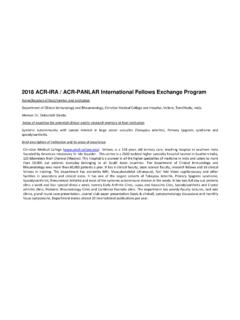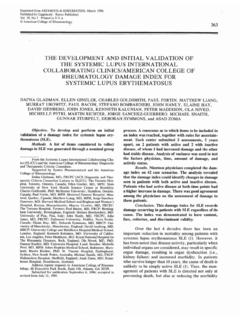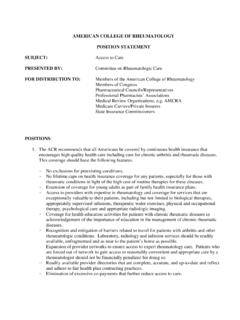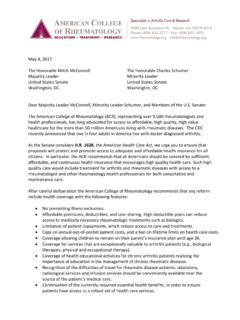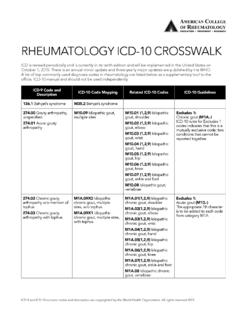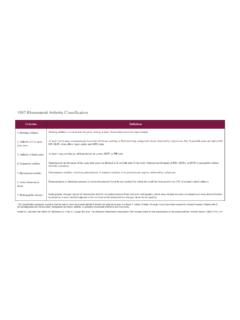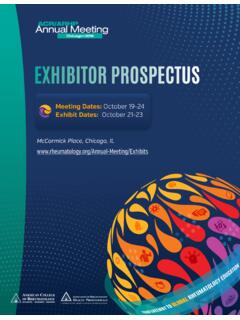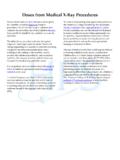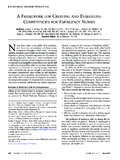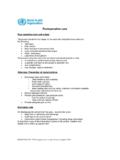Transcription of PRESENTED BY: Committee on Rheumatologic Care
1 american college OF rheumatology . position STATEMENT. subject : Biosimilars PRESENTED BY: Committee on Rheumatologic Care FOR DISTRIBUTION TO: Members of the american college of rheumatology Medical Societies Members of Congress Health Care Organizations/Third Party Carriers Managed Care Entities position : The ACR strongly believes that safe and effective treatments should be available to patients at the lowest possible cost. Decisions regarding the approval and use of biosimilars must be driven by sound science and take into account several observations and guiding principles, including: 1. The size, complexity, and heterogeneity of biologics (and thus biosimilars) necessitate a greater degree of scrutiny in their analytical evaluation than what is required for small molecule generics. 2. In addition to adequate pharmacokinetic and pharmacodynamics studies, clinical data are necessary to ensure the safety and efficacy of biosimilars, and to provide the necessary level of confidence for their use by patients and providers.
2 Furthermore, the collection of long- term post-marketing data for each individual biosimilar is necessary to monitor for less common but nevertheless important adverse events. 3. Post-marketing surveillance studies are needed in children as well as adults, as toxicities and long-term sequelae may be different in these disparate populations. The Best Pharmaceuticals for Children Act (BPCA), which reauthorizes the pediatric studies provision of FDA Modernization and Accountability Act to improve safety and efficacy of pharmaceuticals for children, should apply to biosimilars. 4. The decision to substitute a biosimilar product for a reference drug should only be made by the prescribing provider. In jurisdictions where substitution by someone other than the prescribing provider is lawful, the prescribing provider and the patient should be notified immediately when a substitution is made.
3 Providers must retain the right to write dispense as written for all prescriptions, including biologics. 5. Biosimilars must have distinct names allowing them to be distinguished from each other and their reference products, and furthermore, the 4-letter suffixes which identify each drug should be meaningful. This is essential for effective post-marketing pharmacovigilance. 6. Because some patients with rheumatic diseases may be more susceptible to adverse drug reactions, and because disease states in some organ systems respond differently to one biologic compared to another, extrapolation should be pursued with caution. Regulatory agencies and manufacturers, in consultation with clinical experts free of conflicts of interest, should identify a minimum slate of disease states in which biosimilars should be tested before extrapolation to additional indications is granted. In contrast, off-label use of biosimilars, based on FDA-approved indications of the reference biologic and other data, may be appropriate when deemed by the prescribing provider to be clinically appropriate and in the best interests of the patient, but should be pursued with the same level of caution applied to off-label use of reference agents.
4 7. FDA labels (package inserts) should clearly indicate whether a biosimilar is interchangeable with the reference (originator) biologic. FDA labels should also clearly delineate all indications for which a biosimilar is approved, and specify whether the supporting clinical data for the indication are derived from studies of the biosimilar or the reference biopharmaceutical. BACKGROUND: Biologics are a class of medications produced by living cells using recombinant DNA technology. Biologics have an important role in many areas of medicine, particularly in rheumatology . The high cost of these drugs is a great concern as more products become available and the indications for the treatment of immune-mediated inflammatory diseases expand. Biosimilars, also called follow- on biologics, are a potential cost-saving alternative to reference (also known as originator or innovator ) biologics.
5 The ACR agrees with the need for more cost effective biologic therapeutics and believes that biosimilars offer hope of cost reduction if physicians and patients can be sufficiently reassured of their efficacy and safety through rigorous scientific study of these products [1]. Biologics, as a class of medicines, are inherently far more complex than traditional small molecule drugs. There are three main categories of biologics: (1) products that are almost identical to natural products the body makes, which are often used as replacement therapy or to augment the body's own response; (2) monoclonal antibodies that bind to soluble or cell surface proteins and block pathways or cells; and (3) engineered proteins that mimic receptors (soluble receptors or receptor antagonists), but are soluble and designed to be stable in humans. Biologics are created by incorporating DNA sequences into living cells and utilizing the genetic transcription and protein translation and processing machinery of the specific cell line to produce an engineered protein product.
6 Once the biologic protein is produced in the living cell, an extensive purification process is required to isolate the desired protein. Biologics used in rheumatic diseases are typically large (1000 fold larger than aspirin) monoclonal antibodies (a type of protein) with complex three dimensional structures. This structure determines their function but also gives rise to the risk of adverse events that they may cause. The structure is determined not only by the original DNA sequence but also by multiple post translational modifications which can vary significantly based on the details of the manufacturing process [2]. Companies that produce biosimilars use the reference biologic to reverse engineer the biosimilar product and do not have access to proprietary manufacturing procedures of the original biologic. Therefore, the biosimilar is not expected to be identical to the innovator product.
7 Unfortunately, this creates difficulty in determining whether a biosimilar is similar enough to the reference biologic that physicians and patients can be confident in using the new drug. Variations in manufacturing processes for biosimilars and their reference drugs can have disastrous consequences for patients. This was highlighted through experience with the biologic hormone erythropoietin which is used to treat anemia of chronic kidney disease. After 1998, a marked increase in the number of cases of erythropoietin-associated pure red cell aplasia (PRCA) was reported outside of the US [3]. This life threatening adverse reaction was eventually associated with the subcutaneous use of Eprex, a recombinant human erythropoietin marketed in the European Union but not the US. Investigations eventually identified a minor change in the manufacturing process (a different stabilizer had been used in the manufacturing of Eprex) which is thought to have altered the immunogenicity of subcutaneously dosed Eprex causing patients to mount an antibody response against the recombinant erythropoietin.
8 After these associations were discovered and remedied, the number of cases of PRCA decreased by 90 percent. Unfortunately, problems with recombinant erythropoietin persist. Recent reports from Thailand have identified additional cases of PRCA associated with unspecified biosimilar erythropoietin product(s) thought to be related to less strict regulatory procedures for biosimilar approval in that country [4]. It is imperative that physicians and patients feel confident in the safety and efficacy of approved drugs and the ACR commends the FDA in its commitment to stringent regulation of processes required to approve biosimilars. In the US, the Biologics Price Competition and Innovation (BPCI) Act of 2009. established an abbreviated approval pathway for biologics demonstrated to be biosimilar to an FDA. licensed biological product. The objectives of the BPCI Act are conceptually similar to the Drug Price Competition and Patent Term Restoration Act of 1984 (also known as the Hatch-Waxman Act) that established abbreviated pathways for the approval of generic drugs.
9 The pathway for biosimilar approval is also known as 351(k) [5]. Currently a product can be considered biosimilar to a reference product if, based on data derived from analytical studies, animal studies, and a clinical study or studies, the product is shown to be 'highly similar' to the reference product, notwithstanding minor differences in clinically inactive components, and if there are no clinically meaningful differences in terms of safety, purity and potency. In addition, a biosimilar product may be deemed 'interchangeable' if it meets certain higher standards. According to the FDA, an interchangeable biological product is biosimilar to the reference product, and can be expected to produce the same clinical result as the reference product in any given patient. If administered more than once to an individual (as many biological products are), the risk in terms of safety or diminished efficacy of alternating or switching between the biologic product and the reference product will not be greater than the risk of using the reference product without such alternation or switch [6].
10 Once determined interchangeable two biological products may be substituted for each other ( , interchanged) by a pharmacist as specified by state statutes without intervention from the prescriber. Pharmacists will be responsible for knowing which biological products are interchangeable and which will require a new prescription from the prescribing provider before substitution. The ACR believes that only prescribing providers should be allowed to substitute a biosimilar for the reference biologic or to switch among biosimilars. Due to their intrinsic complexity and immunogenicity, which varies from biologic to biologic [7], and in light of resultant risks to patients as highlighted by the deaths in Europe associated with the use of recombinant erythropoietin, switching among inadequately tested biosimilar drugs and especially without the foreknowledge of prescribers and patients, carries unacceptable risks to patient safety.
